Planar and three-dimensional periodic orbits for Newtonian three-body problem
Xiaoming LI and Shijun LIAO
Shanghai Jiao Tong University, China
Background
The famous three-body problem can be traced back to Newton [1] in 1680s, and attracted many famous mathematicians and physicists such as Euler [2], Lagrange [3] and so on. Poincare [4] found that the first integrals for the motion of three-body system do not exist, and besides orbits of three-body system are rather sensitive to initial conditions. His discovery of the so-called "sensitivity dependence on initial conditions" (SDIC) laid the foundation of modern chaos theory. It well explains why in the 300 years only three families of periodic orbits of three-body system were found by Euler [2] and Lagrange [3], until 1970s when the Broucke-Hadjidemetriou-Henon family of periodic orbits were found [5-9]. The famous figure-eight family was numerically discovered by Moore [10] in 1993 and rediscovered by Chenciner and Montgomery [11] in 2000. In 2013, Suvakov and Dmitrasinovic [12] made a breakthrough to find 13 new distinct periodic orbits by means of numerical methods, which belong to 11 new families. In 2017 Li and Liao [13] found more than six hundred new periodic orbits of three-body system with equal mass, and in 2018 Li et al. [14] further reported more than one thousand new periodic orbits of three-body system with unequal mass. In 2018, Li and Liao [15] reported more than three hundred new collisionless periodic orbits in free-fall three-body problem. In 2021, Li et al. [16] successfully obtained 135445 new periodic orbits with arbitrarily unequal masses by means of combining the numerical continuation method and the Newton-Raphson method, including 13315 stable ones. In 2022, Liao et al. [17] proposed an effective approach and roadmap to numerically gain planar periodic orbits of three-body systems with arbitrary masses by means of machine learning based on an artificial neural network (ANN) model.
In 2025, Li and Liao employed a novel high-precision numerical algorithm to discover 10,059 three-dimensional (3D) periodic orbits in the general three-body problem using a supercomputer [18]. Notably, in the case of three equal masses, they identified twenty-one 3D "choreographic" periodic orbits, where all three bodies move synchronously along a single closed trajectory. Even more intriguingly, for systems with two equal masses, they uncovered 273 "piano-trio" orbits-named for their resemblance to a musical trio-where the two equal-mass bodies trace one shared path while the third follows a distinct one. These findings represent the first reported instances of such 3D periodic orbits, underscoring the groundbreaking nature of their work. The sheer volume of these newly discovered orbits provides unprecedented insights into the chaotic dynamics of the three-body problem, echoing Poincare's assertion that periodic orbits serve as "the only opening through which we can try to penetrate a realm previously deemed inaccessible." This advancement not only expands the known catalog of solutions but also deepens our theoretical understanding of nonlinear celestial mechanics.
The following
show the details of our newly found periodic orbits.
1.
Periodic
orbits with equal mass

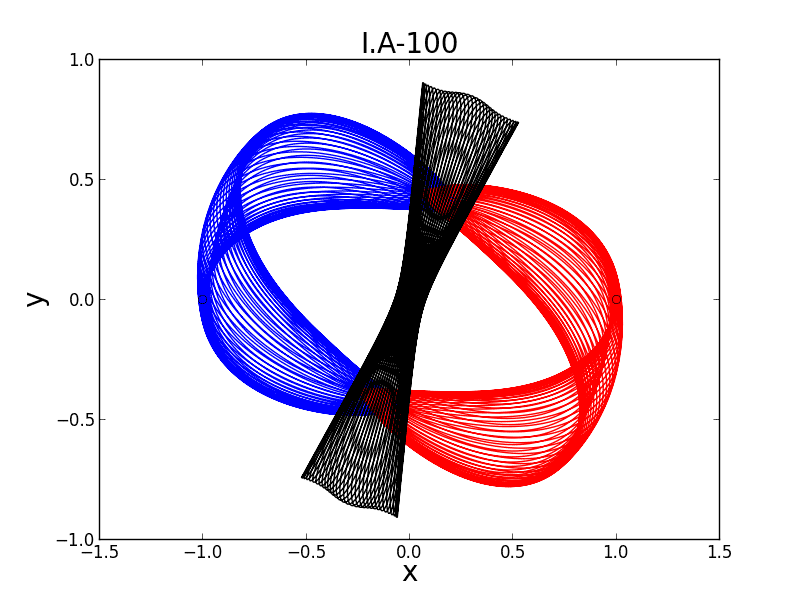
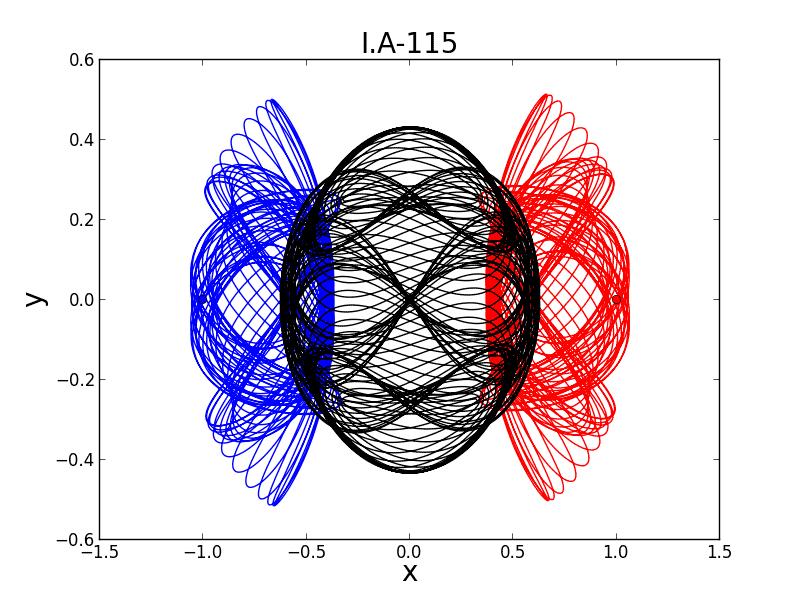



FIG1. The trajectories of six new periodic orbits with equal
mass. Blue line: body-1, red line: body-2, black line: body-3.
On April 28th 2017, we reported 164 families of
planar periodic orbits of the three-body system with equal mass and zero
angular momentum in case of initial conditions with isosceles collinear
configuration, including the well-known Figure-eight family found by Moore in
1993, the 11 families found by Suvakov and Dmitrasinovic in 2013, and more than 100 new families that
have been never reported. They are found by means of the search grid 1000 *
1000 for the initial velocities [0,1] * [0,1] within a
time interval [0,100]. For more detail, please refer to arXiv:1705.00527v2.
On May 30th 2017, we further reported 695 families (including the previous
164 ones) of planar periodic orbits of the three-body system with equal mass
and zero angular momentum in case of initial conditions with isosceles
collinear configuration. They are found by means of the search grid 4000 * 4000
for the initial velocities [0,1] * [0,1] within a
larger time interval [0,200]. More than 600 among them have been never
reported, to the best of our knowledge. For more detail, please refer to arXiv:1705.00527v3.
On July 11th 2017, the final version was updated on ArXiv, mainly for the modification of the names of these
695 families of periodic orbits of the three-body problems. For details, please
refer to arXiv:1705.00527v4.
It was accepted by Science China-Physics, Mechanics & Astronomy for the
publication on July 11th 2017. It was published online on September 11th 2017 (Science
China Physics, Mechanics & Astronomy, 60 (2017), No.12: 129511, doi:10.1007/s11433-017-9078-5) [PDF].
For the detailed characteristic parameters (such as
the periods, the scale-invariant averaged periods, initial velocities and so
on), the definitions and lengths of the so-called free group element (word) of
each orbit, and the movies of these periodic orbits, please visit the websites:
(A) The free
group element (word);
(B) The movies
of periodic orbits in real space and on the shape sphere.
2.
Periodic orbits with unequal mass

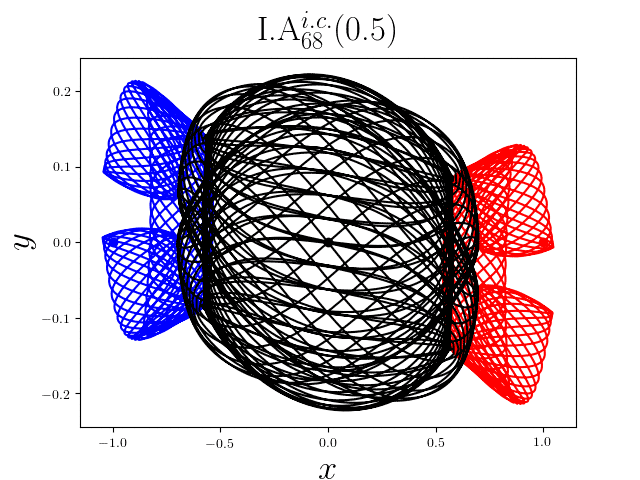
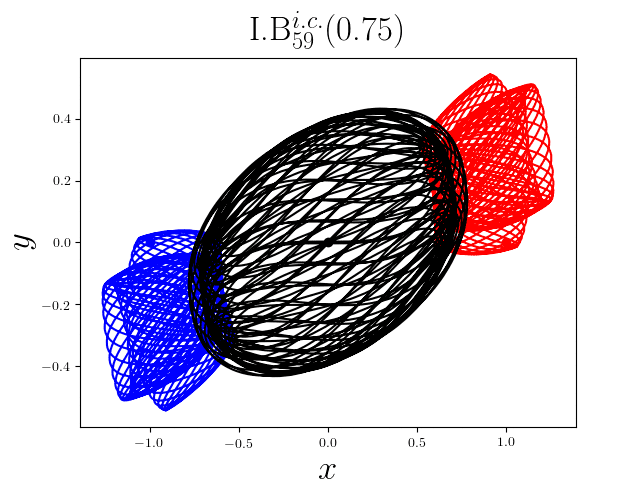
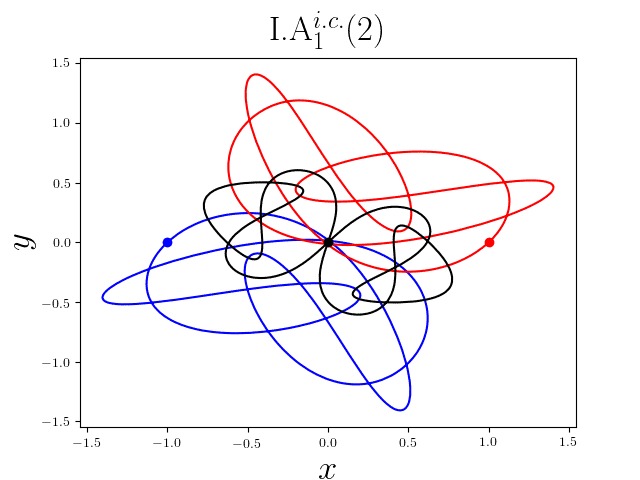
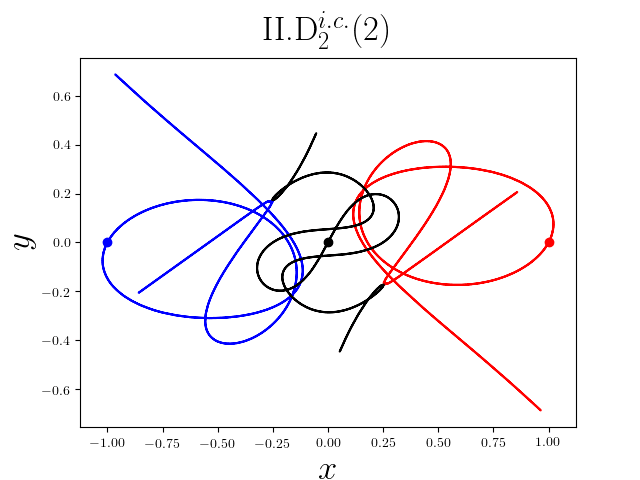
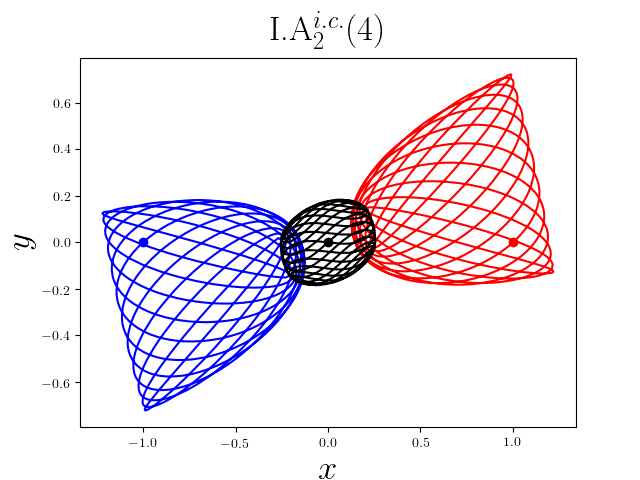
FIG2. The trajectories of six new periodic orbits with unequal mass. Blue line: body-1, red line: body-2, black line: body-3.
On
September 13th 2017, we reported 1349
families of Newtonian periodic planar three-body orbits with unequal mass and
zero angular momentum and the initial conditions in case of isosceles collinear
configurations. These 1349 families
of the periodic collisionless orbits can be divided
into seven classes according to their geometric and algebraic symmetries. Among
these 1349 families, 1223 families are entirely new, to the
best of our knowledge. For more detail, please refer to arXiv:1709.04775
and website.
It was published by Publications of the Astronomical Society of Japan on May 21th,
2018 (doi:10.1093/pasj/psy057) [PDF].
3.
Collisionless periodic orbits in free-fall three-body problem
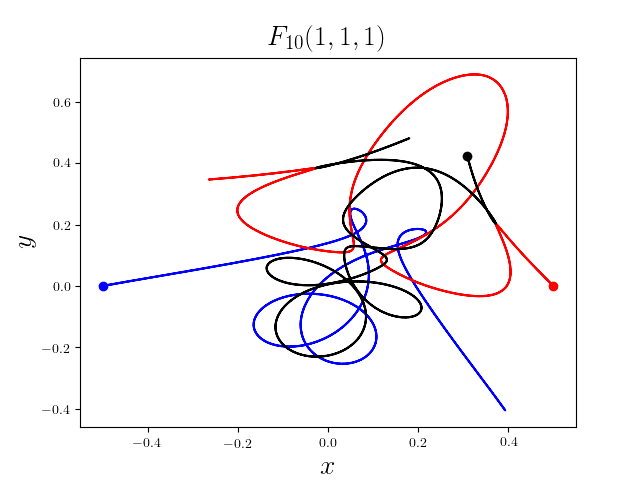
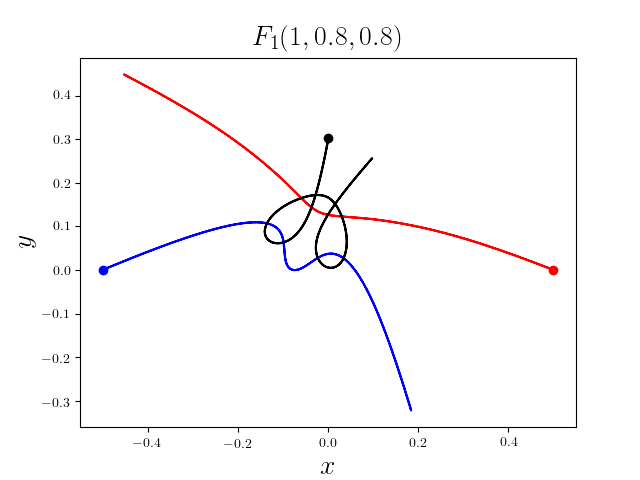

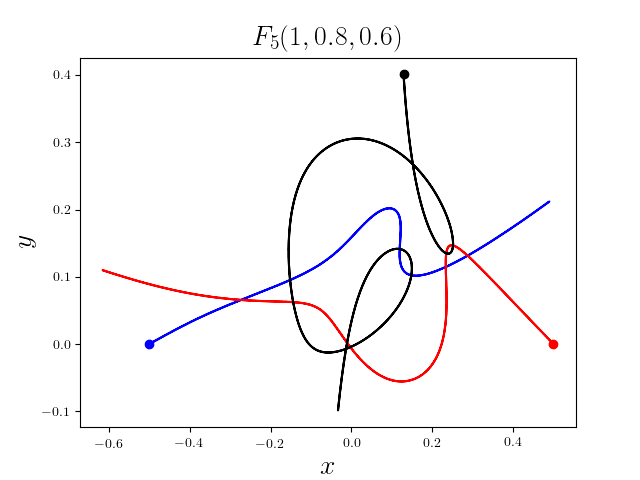
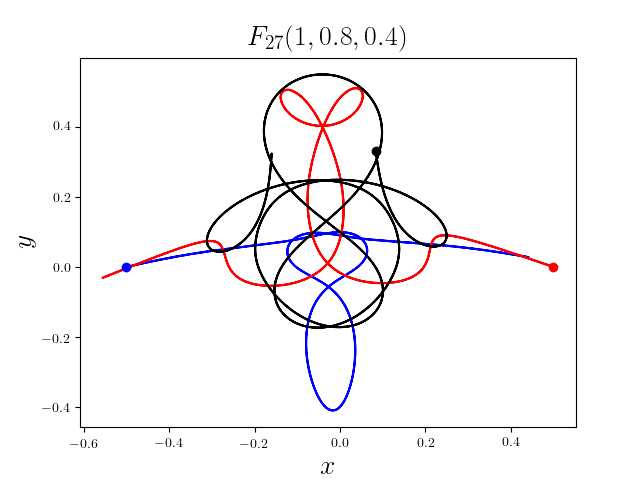
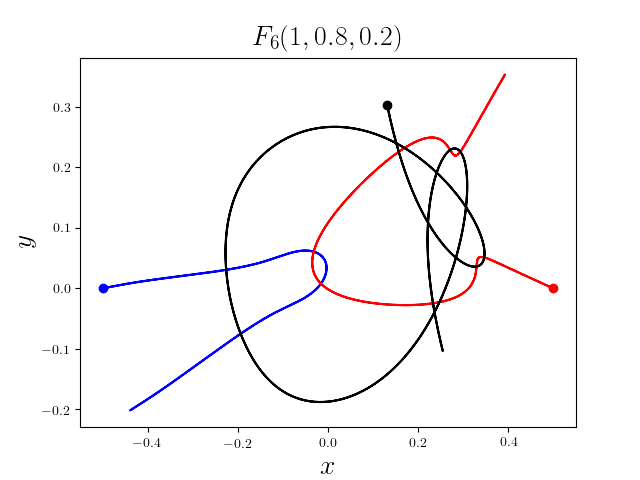
FIG3. The trajectories of six new collisionless free-fall three-body periodic orbits.
Blue line: body-1, red line: body-2, black line: body-3.
On
May 21th 2018, we reported 316 collisionless periodic free-fall three-body orbits with
different mass ratios, including 313
entirely new collisionless periodic orbits. For more
detail, please refer to arXiv:1805.07980
and website.
It was published online on February 1st, 2019 (New Astronomy, 70 (2019), 22-26,
doi:10.1016/j.newast.2019.01.003) [PDF].
4.
Stable non-hierarchical triple systems with fairly large mass region



FIG4. Three newly found stable periodic orbits of non-hierarchical triple systems with different masses and period. (a) m1 = 0.87, m2 = 0.8, m3 = 1 and T = 5.9889127121; (b) m1 = 0.9, m2 = 0.85, m3 = 1 and T = 6.3508660391; (c) m1 = 0.93, m2 = 0.89, m3 = 1 and T = 6.6805531109. Body-1: blue line; Body-2: red line; Body-3: black line.
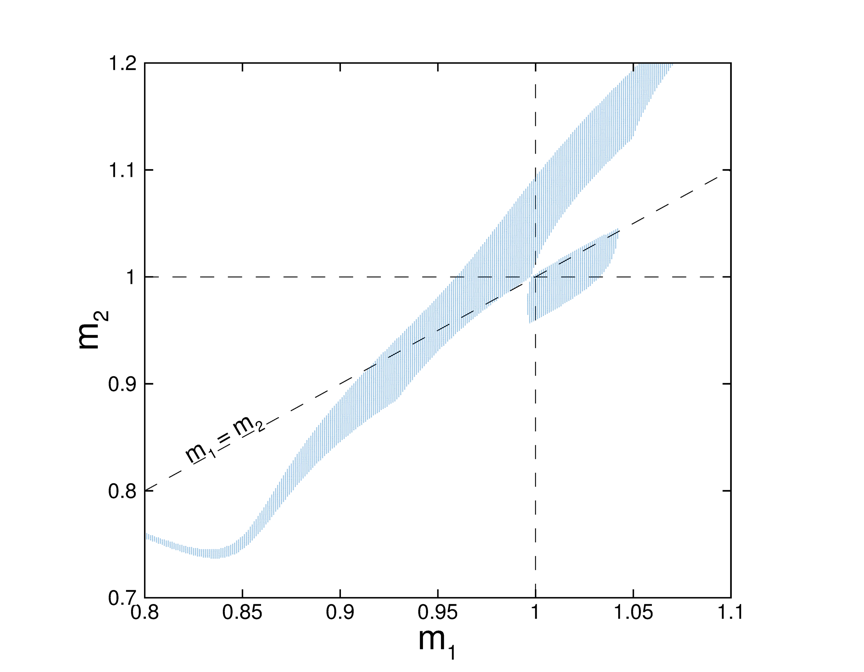
FIG5. The stability region of periodic orbits with m3 = 1 in the m1-m2 plane. Shadowing domain: stable periodic orbits.
It has traditionally been believed that non-hierarchical triple systems would be unstable and thus should disintegrate into a stable binary system and a single star, and consequently stable periodic orbits of non-hierarchical triple systems have been expected to be rather scarce. However, we report here one family of 135445 periodic orbits of non-hierarchical triple systems with unequal masses (see supplementary): 13315 among them are stable. Compared with the narrow mass range (only 10-5) in which stable "Figure-eight" periodic orbits of three-body systems exist, our newly found stable periodic orbits have fairly large mass region as shown in FIG5. We find that many of these numerically found stable non-hierarchical periodic orbits have mass ratios close to those of hierarchical triple systems that have been measured with astronomical observations. This implies that these stable periodic orbits of non-hierarchical triple systems with distinctly unequal masses quite possibly can be observed in practice.
For more details, please refer to:
Xiaoming Li, Xiaochen Li and Shijun Liao, "One family of 13315 stable periodic orbits of non-hierarchical unequal-mass triple systems", Science
China Physics, Mechanics & Astronomy, 64 (2021), 219511 (doi:10.1007/s11433-020-1624-7). [PDF] arXiv:2007.10184.
5.
A roadmap to find periodic orbits of three-body systems with arbitrary masses






FIG6. The relatively periodic BHH satellites orbits of the three-body system with various masses in a rotating frame of reference. The corresponding physical parameters are given by ANN in Table 3 in [PDF]. Blue line: body-1; red line: body-2; black line: body-3.






FIG7. The relatively periodic BHH satellites orbits of the three-body system with various masses in a rotating frame of reference. The corresponding physical parameters are given by ANN in Table 4 in [PDF]. Blue line: body-1; red line: body-2; black line: body-3.
We propose an effective approach and roadmap to numerically gain planar periodic orbits of three-body systems with arbitrary masses by means of machine learning based on an artificial neural network (ANN) model. Given any a known periodic orbit as a starting point, this approach can provide more and more periodic orbits (of the same family name) with variable masses, while the mass domain having periodic orbits becomes larger and larger, and the ANN model becomes wiser and wiser. Finally, we have an ANN model trained by means of all obtained periodic orbits of the same family, which provides a convenient way to give accurate enough predictions of periodic orbits with arbitrary masses for physicists and astronomers. It suggests that the high-performance computer and artificial intelligence (including machine learning) should be the key to gain periodic orbits of the famous three-body problem.
For more details, please refer to:
Shijun Liao, Xiaoming Li and Yu Yang, "Three-body problem - from Newton to supercomputer plus machine learning", New Astronomy, 96 (2022), 101850 (doi:10.1016/j.newast.2022.101850). [PDF] arXiv:2106.11010v2.
For the code, data of periodic orbits, and the trained ANN models, please refer to the websites:
1. Code
The code "ANN_3body.py" is to train the ANN model with the periodic orbits of the three-body problem.
The code "Eval_3body.py" is to use the trained ANN model to predict the initial conditions and period of the periodic orbits.
The code "Classify_orbit.py" is to train the ANN model to classify the orbits and use the trained model to predict the type of the orbits.
2. Data
This folder contains all the periodic orbits found and the classifications of the orbits for the two cases in the paper.
3. Model
This folder contains the trained ANN models for the two cases in the paper.
6. Three-dimensional periodic orbits of general three-body problem






FIG8. 3D periodic orbits of general three-body problem. Blue circle: Body-1; Red circle: Body-2; Green circle: Body-3.




FIG9. 3D choreographic periodic orbits of three-body problem in the case of m1=m2=m3=1. Three bodies move along a single closed orbit (green). Blue circle: Body-1; Red circle: Body-2; Green circle: Body-3.




FIG10. 3D "piano-trio orbits" of three-body problem with two bodies (m1=m2=1) moving along a single closed orbit (red) but the third (m3≠1) along a distinct orbit (green).
Blue circle: Body-1 (m1=1); Red circle: Body-2 (m2=1); Green circle: Body-3 (m3≠1).
A very few three-dimensional (3D) periodic orbits of the general three-body problem (with three finite masses) have been discovered since Newton first mentioned it in the 1680s. Using a high-accuracy numerical strategy, we discovered 10,059 three-dimensional periodic orbits of the three-body problem in cases where m1=m2=1 and m3=0.1×n (where 1≤n≤20 is an integer), among which 1,996 (about 20%) are linearly stable. Our approach remains valid for arbitrary mass m3, meaning we can theoretically obtain an unlimited number of 3D periodic orbits for the three-body problem.
In the case of three equal masses, we discovered twenty-one 3D "choreographic" periodic orbits, where all three bodies move synchronously along a single closed trajectory. Remarkably, for systems with two equal masses, we identified 273 "piano-trio" orbits-named for their resemblance to a musical trio-where the two equal-mass bodies follow one shared path while the third traces a distinct orbit. To our knowledge, none of these 3D periodic orbits have been previously reported, highlighting the novelty of this work. The abundance of these new solutions provides unprecedented insights into the chaotic nature of the three-body problem, recalling Poincaré's observation that periodic orbits represent "the only opening through which we can attempt to access a domain that has thus far remained inaccessible."
For details, please refer to arXiv:2508.08568v1.
For initial conditions and other parameters, download the supplementary materials:
References
[1] I. Newton, Philosophiae naturalis principia mathematica (London: Royal Society Press, 1687).
[2] L. Euler, "De motu rectilineo trium corporum se mutuo attrahentium", Novi commentarii academiae scientiarum Petropolitanae 11,
144-151
(1767).
[3] J.L. Lagrange, "Essai sur le probleme des trois corps", Prix de lacademie royale des Sciences de paris 9, 292 (1772).
[4] J. H. Poincare, "Sur le probleme des trois corps et les equations de la dynamique", Acta Mathematica 13, 1-271 (1890).
[5] R. Broucke, "On relative periodic solutions of the planar general three-body problem", Celestial Mechanics 12, 439-462 (1975).
[6] J. D. Hadjidemetriou, "The stability of periodic orbits in the three-body problem", Celestial Mechanics 12,
255-276 (1975).
[7] J. D. Hadjidemetriou and T. Christides, "Families of periodic orbits in the planar three-body problem", Celestial mechanics 12, 175-187 (1975).
[8] M. Henon, "A family of periodic solutions of the planar three-body problem, and their stability", Celestial
mechanics 13, 267-285 (1976).
[9] M. Henon, "Stability of interplay motions", Celestial
mechanics 15, 243-261 (1977).
[10] C. Moore, "Braids in classical gravity", Physical Review Letters 70, 3675-3679 (1993).
[11] A. Chenciner and
R. Montgomery, "A remarkable periodic solution of the three-body problem in the case of equal masses", Annals of Mathematics 152, 881-901 (2000).
[12] M. Suvakov and V. Dmitrasinovic, "Three classes of Newtonian three-body planar periodic orbits", Physical Review Letters 110, 114301
(2013).
[13] X. Li and S. Liao, "More than six hundred new families of Newtonian periodic planar collisionless three-body orbits", SCIENCE CHINA Physics,
Mechanics & Astronomy 60, 129511 (2017). [PDF]
arXiv:1705.00527v4
[14] X. Li, Y. Jing, and S. Liao, "Over a thousand new periodic orbits of a planar three-body system with unequal masses", Publications of the Astronomical Society of Japan 00 1-7 (2018).
[PDF]
arXiv:1709.04775
[15] X. Li and S. Liao, "Collisionless periodic orbits in the free-fall three-body problem", New Astronomy 70, 22-26 (2019). [PDF]
arXiv:1805.07980
[16] X. Li, X. Li and S. Liao, "One family of 13315 stable periodic orbits of non-hierarchical unequal-mass triple systems", SCIENCE CHINA Physics,
Mechanics & Astronomy 64, 219511 (2021). [PDF]
arXiv:2007.10184
[17] S. Liao, X. Li and Y. Yang, "Three-body problem - from Newton to supercomputer plus machine learning", New Astronomy 96, 101850 (2022). [PDF]
arXiv:2106.11010v2
[18] X. Li and S. Liao, "Discovery of 10,059 new three-dimensional periodic orbits of general three-body problem", arXiv:2508.08568 (2025). [PDF]
All of the above results are available on GitHub
Visitor count and geographic distribution (since July 15th, 2025):